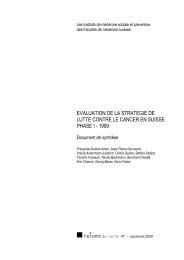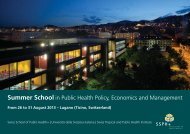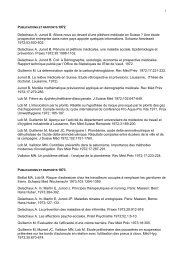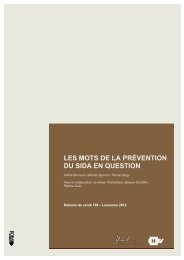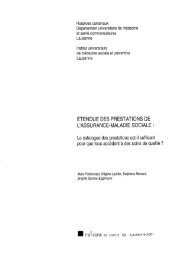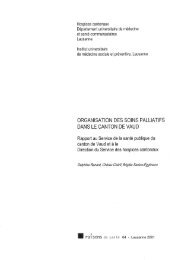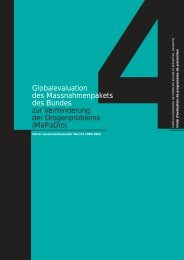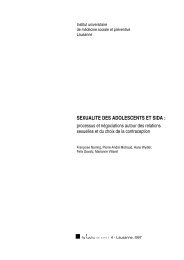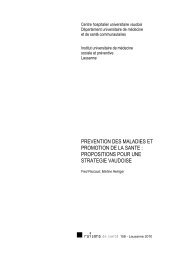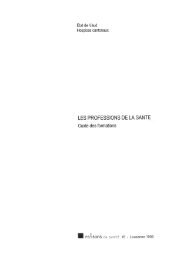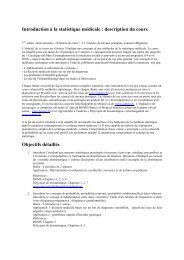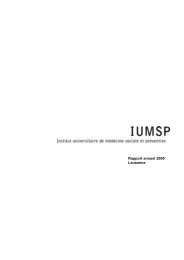unité d'épidémiologie du cancer - IUMSP
unité d'épidémiologie du cancer - IUMSP
unité d'épidémiologie du cancer - IUMSP
You also want an ePaper? Increase the reach of your titles
YUMPU automatically turns print PDFs into web optimized ePapers that Google loves.
ACTIVITÉS<br />
ACTIVITÉS DE L’UPC<br />
Pedro Marques-Vidal<br />
Tuteur <strong>du</strong> master en médecine de Mme Michelle Reavey « Périodicité de la maladie<br />
cardiovasculaire en Suisse » (en cours).<br />
Collaborations et activités scientifiques<br />
CoLaus study<br />
The CoLaus Study (COhorte LAUSannoise) is a population-based whole genome scan<br />
association study on the genetic determinants of cardiovascular risk factors (PI: Profs<br />
Peter Vollenweider and Gérard Waeber), in collaboration with the pharmaceutical<br />
company GSK and the department of Medical Genetics (Head: Dr Jacques Beckmann,<br />
CHUV and UNIL). A random sample of 6188 Caucasian indivi<strong>du</strong>als has been<br />
collected from the Lausanne area. Several manuscripts (with and without genetic data)<br />
have been published, including several publications in Nature Genetics. Other<br />
manuscripts are in preparation.<br />
BALLABEINA, YOUPLABOUGE and PURZELBAUM studies (Dr. Jardena Puder)<br />
The <strong>IUMSP</strong> (Dr Pedro Marques-Vidal) is partly responsible for data management and<br />
analysis. The aim is to assess the best methods to prevent overweight and obesity in<br />
kindergarten. Two papers have been published and several others are in preparation.<br />
KISS ("Kinder-Sportstudie KISS") study<br />
The <strong>IUMSP</strong> (Dr Pedro Marques-Vidal) collaborates in the analysis of the data. The<br />
KISS is a school-based randomized, controlled trial aiming to increase overall physical<br />
activity and to improve fitness and health in 6- to 13-year-old children in the<br />
Basel/Aargau region. 15 schools were randomized to the intervention (n = 9) or the<br />
control (n = 6) group, stratified by geographic region (urban vs. rural) and by age (1st<br />
and 5th grade). Participation was given for all children in the intervention group since<br />
in this group the intervention was part of the normal school curriculum. The<br />
intervention <strong>du</strong>ring one academic year consisted of: 1) two additional physical<br />
e<strong>du</strong>cation classes per week given by trained physical e<strong>du</strong>cation teachers adding up to a<br />
total of five PA (Physical Activity) classes per week, 2) short PA breaks (2–5 min<br />
each) <strong>du</strong>ring academic lessons, 3) PA homework, and 4) adaptation of recreational<br />
areas around the school.<br />
All children underwent anthropometric measurements, blood pressure assessment,<br />
fitness testing, measurement of PA and they filled out questionnaires. At least 70% of<br />
all children agreed to blood sampling and measurements of body composition and<br />
bone mineral measurements by <strong>du</strong>al energy x-ray absorptiometry. The primary<br />
endpoints of the study after one year were an increase in total PA by accelerometry, an<br />
increase in aerobic fitness measured by the 20 m shuttle run, a decrease in percent<br />
body fat derived from skinfold measurements and an increase in quality of life as<br />
assessed by the child health questionnaire in the intervention group compared to the<br />
control group. Secondary outcomes were overall fitness, differences in body<br />
composition including body fat distribution, cardiovascular risk factors, psychosocial<br />
health, bone mineral content and density of femur, lumbar spine and total body and<br />
food intake. More information (in German) at<br />
http://issw.unibas.ch/article/index_section.php3np=1057.<br />
36



